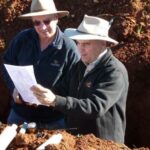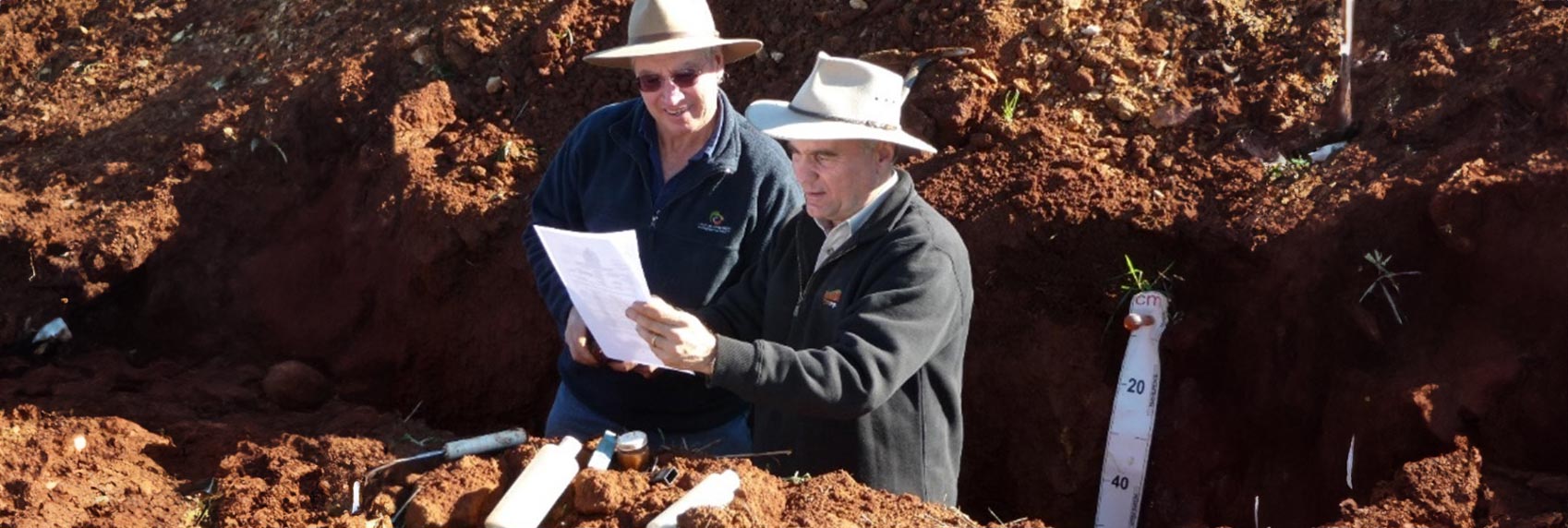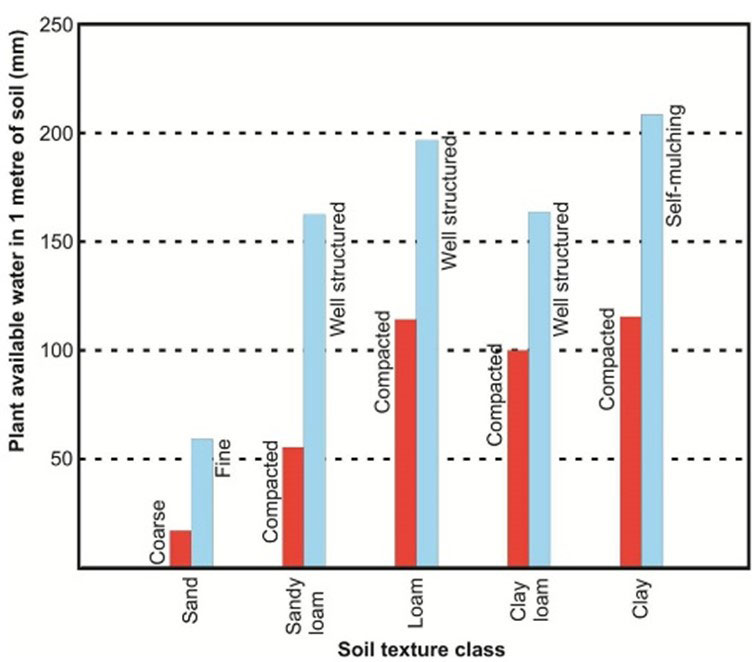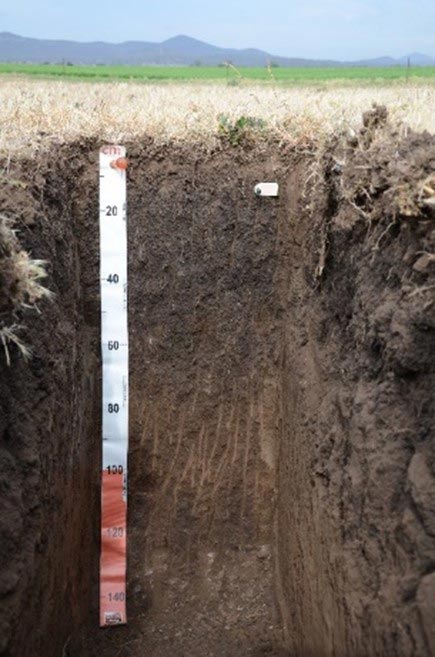Facts & Resources
Soil Structure: At Least as Important as Soil Carbon!

Soil management, especially soil carbon has been a prominent news item in Australian rural media during 2023-24
Soil carbon has been the main focus. There has been an avalanche of articles for farmers about this topic in ‘The Land’ newspaper October 2023 to May 2024. But an issue of fundamental importance usually is missing – SOIL STRUCTURE.
For the food production zones of a farm, the aim is to have soil structure that mostly is stable in water and not strongly compacted – in addition to desirable pH and nutrition, favourable field slope, a freedom from toxicities such as salinity, use of mulches to protect the soil surface, and as much soil carbon as possible to 1) supply food for beneficial soil organisms and 2) provide a slow-release source of nutrients for plant growth.
High quality structure in topsoil and subsoil allows:
- quick water entry instead of wasteful runoff, and;
- the maximising of water storage in loam and clay soils – see below.
Source: https://www.tasfarmingfutures.com.au/soil-handbooks-ute-guides AUSVEG Healthy Soils for Sustainable Vegetable Farms Fig. 4.19.
In water-constrained landscapes, increases in plant available water boost plant growth and farm profitability. It is important though to note that The University of Sydney (Minasny and McBratney, 2018) found the increase in organic carbon in soil has a surprisingly small effect on soil water retention: A 1% mass increase in soil OC on average increases available water capacity by only 1.16 mm per 100 mm depth of soil. The increase is larger in sandy soils than in loams and clays. Soil water retention is reduced as gravel content increases.
READ MORE: Minasny B, McBratney AB (2018) Limited effect of organic matter on soil available water capacity. European Journal of Soil Science 69 (1), 39-47.
Therefore decompaction of a soil profile, in conjunction with organic and inorganic stabilisation of the new fissures and aggregates, is the main soil management technique to consider when improving soil water holding capacity on a farm with compaction challenges. This loosening of soil – biologically via shrinkage crack and biopore formation and/or mechanically with a deep ripper – needs to be followed by ‘controlled traffic farming’ to minimise re-compaction of soil.
Very importantly, favourable soil structure:
- encourages prolific and deep growth of plant roots and associated beneficial fungi because of minimal soil hardness when dry and adequate aeration when moist – this gives improved grain and dry matter yields and may boost soil carbon.
- provides a desirable physical habitat for beneficial soil organisms.
Greenhouse gas reporting for Australian farms is becoming a mainstream activity. Biological processes such as carbon sequestration, and loss of N-fertiliser via nitrous oxide emissions, are strongly influenced by soil structural form (compaction severity). But measurement of this soil factor is challenging given that much of the action with biological activity in soil is associated with “hot spots” that occupy only a small percentage of soil volume. Photography and image analysis of carefully trimmed profiles from soil pits, or large-diameter split cores, is the only way currently to accurately quantify biologically important soil structural features on a farm – but professional soil profile description and photography by soil pit experts (“pedologists”) will quickly provide an informative and cost-effective ‘first approximation’.
READ MORE: Kuzyakov Y, Blagodatskaya E (2015) Microbial hotspots and hot moments in soil: Concept & review. Soil Biology & Biochemistry 83, 184-199.
The best way to learn about soil structure description and management in both the crop production and biodiversity conservation zones of farms is through the use of soil inspection pits in the field. They provide a relaxed and practical setting for farm managers and soil experts to compare notes and learn from each other about soil constraints and their management.
When soil profiles are professionally trimmed and well photographed, the images can withstand scrutiny in a court of law. The highlighting of continuous vertical pores with white paint applied to the surface improves the images; pH indicator can be applied to illustrate acidity/alkalinity trends. Visual evidence from soil profiles cannot be argued with: Soil pits never lie!
Soil pit faces also allow core samples to be located sensibly; for example, when taking unbiassed bulk density measurements to accompany soil carbon audits on farms. Bulk density measurement is an important option for assessing soil structural form, but the sampling rings need to have a diameter of at least 75mm, and correction for water content is advisable in cracking clays. The use of narrow diameter cores almost certainly will introduce serious errors with soil structure assessment, particularly when the soil is moist.
Soil carbon is partially protected from decomposition losses within compact aggregates that have limited oxygen supply. This is an important issue when trying to maximise carbon accumulation and earn money from carbon credits. But if too much of the root zone is compacted, restricted root growth will retard crop productivity and organic carbon inputs; and unwanted nitrous oxide release may exceed ‘greenhouse gas’ emission targets for a farm.
Visual-tactile soil structure assessment is considered by some to be too slow and costly when carried out professionally using methods described by:
- CABI UK textbook: ‘Visual Soil Evaluation’: https://www.cabidigitallibrary.org/doi/book/10.1079/9781780644707.0000
- Emmet-Booth et al. (2016). A review of visual soil evaluation techniques for soil structure. Soil Use and Management 32, 623-634.
But attempts to use quick low-cost geophysics techniques such as EMI to assess topsoil and subsoil structure usually fail to produce meaningful data and is a very poor alternative. Remember: “Sometimes cheap is just too expensive”.
READ MORE: The GRDC ‘Dispersive Soil Manual’ (pages 18-21) describes the limitations of EM surveys for soil structural stability assessment:
A failure to accurately measure, map (traffic-light coding) and optimise (through improved land management) the three aspects of topsoil and subsoil structure – form, stability in water, and resilience – on Australian farms allows costly soil-induced yield gaps to persist, year after year, for decades. The end result at the farm scale often is poor profitability, inadequate environmental services, suppressed land values and unhappy farmers.
Soil structure assessment therefore is a cornerstone of rural land management in Australia: It is at least as important as soil carbon measurements. Global issues associated with the poor management of soil structure in agriculture include food insecurity and serious degradation of the environment.




